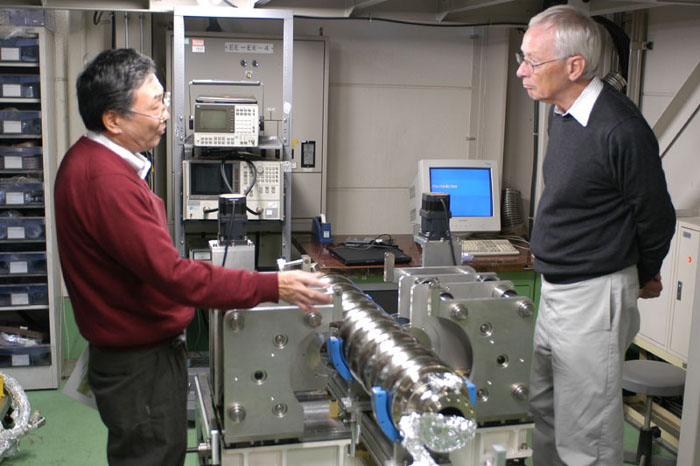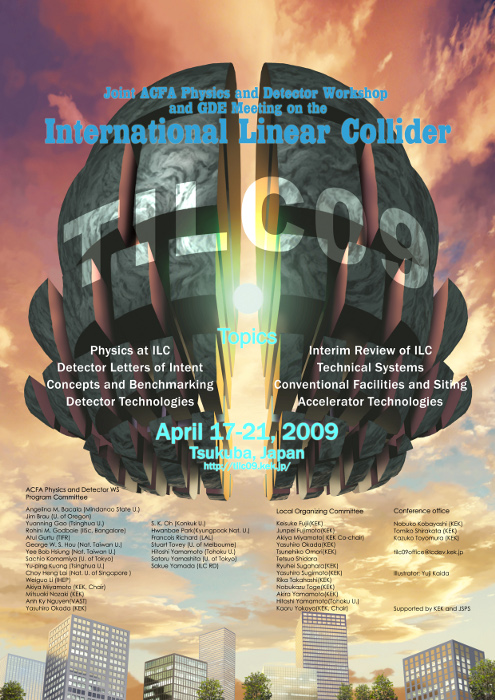Director's Corner
19 February 2009
 Barry Barish |
TILC09 will have some special features
TILC09 will be held in Tsukuba, Japan, from 17 to 21 April 2009: We will once again share a venue for the Global Design Effort meeting with an ILC physics and detector workshop. These joint meetings help bring us all together as a single community. The GDE portion of the meeting will be unique, and to some extent it represents an experiment in itself. It will consist of the usual plenary and parallel sessions on our key topics, but in addition, embedded in the meeting there will be an ambitious three-and-a-half-day internal technical review of our R&D programme. This review is the culmination of efforts by the Accelerator Advisory Panel (AAP) to initiate a series of yearly in-depth technical reviews. We have lacked such reviews in the past and we hope that this will mark the beginning of a healthy internal process for validating our technical work and receiving fresh new ideas and suggestions.
TILC will be the eleventh meeting on the physics and detector of the ILC organised by the Asian Committee for Future Accelerators (ACFA) joint Linear Collider Physics and Detector Working Group and it also will be the eleventh major meeting of the GDE. The two meetings will share opening and closing plenary sessions on the first day (17 April) and the last day (21 April). In addition, there will be parallel sessions during the three other days. Special features of the meeting will include the Accelerator Advisory Panel reviews for the GDE and the initiation of the International Detector Advisory Group (IDAG) review process of the submitted Letters of Intent (LOI) for detectors. There will also be special programmes for the public and for school kids.
We welcome the LOI designs as they will make for a realistic accelerator design that fully takes account of detector requirements and will help us to understand any physics or detector issues when optimising the design. For example, an important consideration will be to accommodate the proposed LOI detectors in the proposed "push-pull" system in the interaction region. In addition, we plan to study various machine-detector-interface issues, as well as accelerator issues that could affect the physics performance of the detectors.
 Bill Willis of Columbia University discussing the intricacies of superconducting RF cavities with Kenji Saito of KEK. Bill Willis of Columbia University discussing the intricacies of superconducting RF cavities with Kenji Saito of KEK. |
Bill Willis, chair of the AAP, and Eckhard Elsen, co-chair, are organising the AAP efforts towards the GDE technical review. As the first such review, most of the areas of ILC R&D and design will be covered, but in addition, they plan to provide selected in-depth reviews in a few areas where crucial decisions or deliverables are planned in the short term. The areas listed below have been chosen as focus points for the more concentrated reviews:
- Superconducting RF (SRF)
- Electron Cloud
- Conventional Facilities and Siting (CF&S)
- Test Facilities
The AAP has written down a rather detailed outline, overview and context for the review that defines the structure and focus of the review, including the detailed agenda and support materials required. Finally, the efforts underway to simplify the design by optimising for cost to schedule and to risk (called minimum machine studies) will also be a theme of the review. The minimum machine studies could have consequences for the tunnel layout and/or affect many accelerator systems. Therefore options under study will be included in the presentations.
I have been pushing for a process of rigorous 'internal' technical reviews of our work for some time now, because I have felt this will be especially important as we proceed through the technical design phase. Although the AAP review process is added on top of the independent external reviews by the ILCSC Project Advisory Committee (PAC), all efforts are being made to make these reviews complement each other. The PAC mandate is broader and includes physics and detectors. They will focus less on technical details and more on global issues leading to a project proposal. I am optimistic that the coming AAP technical review will be very revealing, providing us with important technical checks and balances, and as a result they will make useful technical insights and give us good advice for the future.
TILC09 should be an exciting and content filled meeting. Join us!
-- Barry Barish

